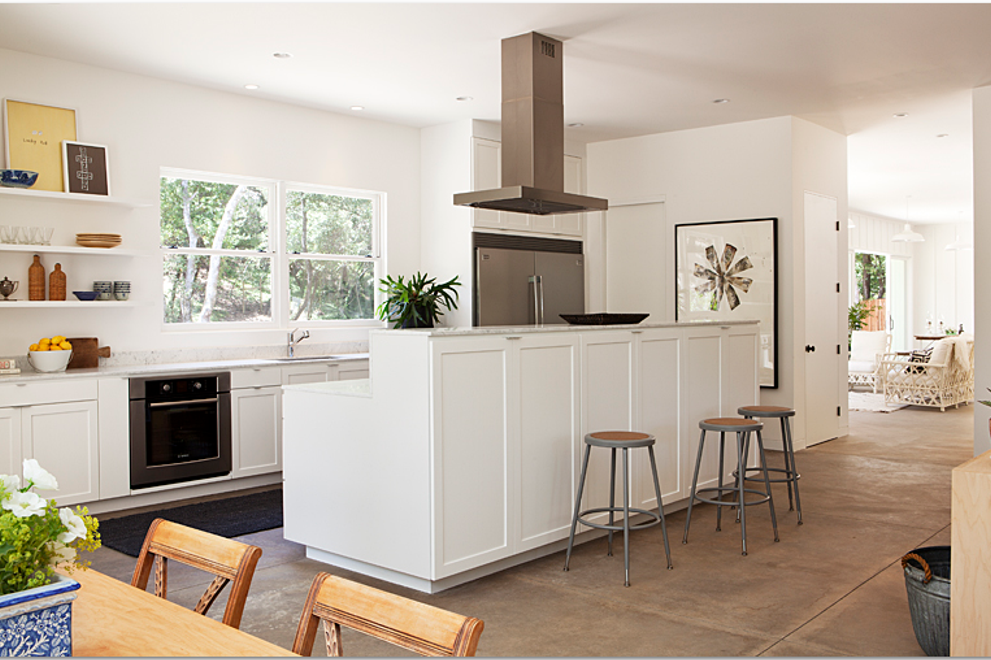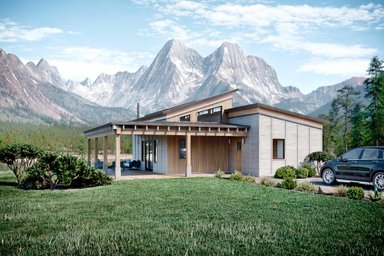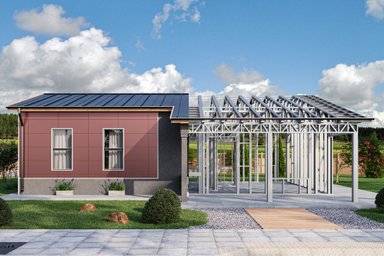No matter what the size of your kitchen, it is undoubtedly the
center of your home. And as you contemplate a new home, it is tempting to dream
about one the size of a ballroom, so you really have room for family and
friends.
In the late 1980’s, the walls around the kitchen came tumbling
down. This open-plan house created a giant-sized culinary center. Great ideas
on paper, but does this really function as workable kitchen? Walking ten feet from
the sink to the refrigerator is a waste of time and energy. Remember you can
walk up to 100 miles in a year’s time in a larger scaled kitchen. Similarly if
appliances are spread out in a vast room, the cook will be exhausted by the end
of the meal preparation and clean-up.
Because most of us do not entertain non-stop, it is important to look at our own culinary needs and what works for us. Remember it takes as much planning to create a compact kitchen as an ample one. The point is that the kitchen should work for the cook first and then the rest. The latest kitchen designs have led to more efficient layouts that create a cooking room within a room. This concept gives you plenty of room for your culinary tasks as well as space for your guests to be comfortably seated but not in your way.
The kitchen within a larger space works best if you have an L-shaped kitchen plan with a large island or a G-shaped kitchen plan. Another layout is a free-standing corridor kitchen, with two parallel counters or even islands. These designs keeps your activities within an efficient space and the friends and family close by.
Outside the kitchen work area, plan for your guests’ comfort. Will they sit on bar stools, lean against the counter, relax in freestanding chairs or sofa or gather at an adjacent table and chairs? Much depends on how you expect to entertain – casual or more formal? Also will you plan to be eating in the kitchen itself or in a nearby area? Design the space so that you have adequate room for family and friends, wherever you decide to place them, but do so before you complete your kitchen plan. Creating a warm and welcoming kitchen that becomes a new living space requires a true balance of your needs and your wants. Take your time to plan the space carefully.
Kitchen Planning Guide A few guidelines to get you started with your new live-in kitchen:
Because most of us do not entertain non-stop, it is important to look at our own culinary needs and what works for us. Remember it takes as much planning to create a compact kitchen as an ample one. The point is that the kitchen should work for the cook first and then the rest. The latest kitchen designs have led to more efficient layouts that create a cooking room within a room. This concept gives you plenty of room for your culinary tasks as well as space for your guests to be comfortably seated but not in your way.
The kitchen within a larger space works best if you have an L-shaped kitchen plan with a large island or a G-shaped kitchen plan. Another layout is a free-standing corridor kitchen, with two parallel counters or even islands. These designs keeps your activities within an efficient space and the friends and family close by.
Outside the kitchen work area, plan for your guests’ comfort. Will they sit on bar stools, lean against the counter, relax in freestanding chairs or sofa or gather at an adjacent table and chairs? Much depends on how you expect to entertain – casual or more formal? Also will you plan to be eating in the kitchen itself or in a nearby area? Design the space so that you have adequate room for family and friends, wherever you decide to place them, but do so before you complete your kitchen plan. Creating a warm and welcoming kitchen that becomes a new living space requires a true balance of your needs and your wants. Take your time to plan the space carefully.
Kitchen Planning Guide A few guidelines to get you started with your new live-in kitchen:
- Before you begin to plan your kitchen, take an inventory of all you presently store in your kitchen. Weed out duplicates or store unnecessary items elsewhere or close by.
- Allocate enough space for cooking, serving and cleanup. Keep a minimum of 24 to 30 inches between appliances.
- Locate small appliances in one central place for well-organized use. Do not leave them on the counter if not used daily.
- Keep sinks, dishwasher and trash container close together for efficient clean-up.
- Similarly, create a work space between the refrigerator and cooktop with mixing bowls, knives and utensils stored nearby.
- Ventilation is very important in an open space kitchen. Work what is needed for proper exhaust into the plan early in the design process, lest you forget.
- Use an easy-access pantry as adjacent storage. They can hold paper supplies, extra china, glassware and platters in addition to food stuffs and beverages.
- Wine storage should be convenient to cooks as well as guests. Determine how much you plan to store on a regular basis
- Bar stools need 25 to 30 inches from the center of one stool to the next. To determine how many stools will fit at a counter, divide its length in inches by 28. That is how many stools will fit.
- Measure the height of the counter to ensure a perfect fit. To sit comfortably at the counter, allow 10 to 12 inches between the top of the seat and the bottom of the eating surface.
- If planning for a table and chairs, allow 36 inches between the back of the dining chair and the wall or other furniture.
- Also
allow at least 30 inches for pass-by space behind or in front of a chair,
if freestanding.






